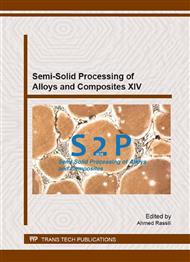[1]
LLOYD D J. Particle reinforced aluminium and magnesium matrix composites [J]. International Materials Review, 1994, 39(1): 1-23.
Google Scholar
[2]
ZHANG H W, GENG L, GUAN L N, et al. Effects of SiC particle pretreatment and stirring parameters on the microstructure and mechanical properties of SiCp/Al-6. 8Mg composites fabricated by semi-solid stirring technique[J]. Materials Science and Engineering: A, 2010, 528(1): 513-518.
DOI: 10.1016/j.msea.2010.09.046
Google Scholar
[3]
BINDUMADHAVAN P N, CHIA T K, CHANDRASEKARAN M, et al. Effect of particle-porosity clusters on tribological behavior of cast aluminum alloy A356-SiCp metal matrix composites [J]. Materials Science and Engineering: A, 2001, 315(1-2): 217-226.
DOI: 10.1016/s0921-5093(00)01989-4
Google Scholar
[4]
Miracle DB. Metal matrix composites – from science to technologysignificance. Compos SciTechnol 2005; 65: 2526–40.
Google Scholar
[5]
KACZMAR W, PIETRZAK K, WLOSINSKI W. The production and application of meta matrix composite materials [J]. Journal of Materials Processing Technology, 2000, 106(1-3): 58-67.
DOI: 10.1016/s0924-0136(00)00639-7
Google Scholar
[6]
ManchangGui, Suk Bong Kang, KwangjunEuh. Influence of SprayingCondition on Microstructures of Al-SiCp Composites by Plasma Spraying. Metallurgical and Materials Transaction, 2005, 36A(9): 2471-2480.
Google Scholar
[7]
Chen G, Jiang L, Zhang Q, Wu G, Luan B. The thermal expansionand mechanical properties of high reinforcement content SiCp-Alcomposites fabricated by squeeze casting technology. Composites A2003; 34: 1023–7.
DOI: 10.1016/s1359-835x(03)00253-7
Google Scholar
[8]
Rohatgi P K, Ranganathan N, Shetty H R. Use of Metal Coated Refractory Powders to Make Particulate Composites by Infiltration[J]. Composites, 1978, 9(3): 153-156.
DOI: 10.1016/0010-4361(78)90340-3
Google Scholar
[9]
Junyou L, Shiben W, Zhongliang S, Geying A. A new process for thefabrication of in situ particle reinforced metal matrix composites. J. Mater Process Technol 1997; 63: 354–7.
Google Scholar
[10]
TJONG S C, MA Z Y. Microstructural and mechanical characteristics of situ metal matrix composites[J]. Materials Science and Engineering: R, 2000, 29(3-4): 49-113.
DOI: 10.1016/s0927-796x(00)00024-3
Google Scholar
[11]
HASHIM J, LOONEY L, HASHMI M S J. Particle distribution in cast metal matrix composites-partI[J]. Journal of Materials Processing Technology, 2002, 123(2): 258-263.
DOI: 10.1016/s0924-0136(02)00099-7
Google Scholar
[12]
Laurent V, Jarry P, Regazzoni G, et al. Processing-Microstructure Relationships in Composition cast Magnesium/SiC[J]. Journal of Materials Science, 1992, 27: 4447-44.
DOI: 10.1007/bf00541578
Google Scholar
[13]
GENG L, ZHANG H W, LI H Z, et al. Effects of Mg content on microstructure and mechanical properties of SiCp/Al-Mg composites fabricated by semi-solid stirring technique [J]. Transactions of Nonferrous Metals Society of China, 2010, 20: 1851-1855.
DOI: 10.1016/s1003-6326(09)60385-x
Google Scholar
[14]
Mirzadeh H and Niroumand B. Fluidity of Al-Si semisolidslurries during rheocasting by a novel process. Journal ofMaterials Processing Technology, 2009, 209: 4977-4982.
DOI: 10.1016/j.jmatprotec.2009.01.020
Google Scholar
[15]
Chen H I, Chen J C, and Liao J J. The influence of shearingconditions on the rheology of semi-solid magnesium alloy. Materials Science and Engineering A, 2008, 487: 114-119.
DOI: 10.1016/j.msea.2007.09.072
Google Scholar
[16]
Li Yageng, Mao Weimin, Zhu Wenzhi, et al. Rheologicalbehavior of semi-solid A357 aluminum alloy at steady state. China Foundry, 2014, 11(2): 79-84.
Google Scholar
[17]
Birol Y. Solid fraction analysis with DSC in semi-solid metal processing. J. Alloy Compd., 2009, 486: 173-177.
DOI: 10.1016/j.jallcom.2009.06.165
Google Scholar
[18]
Blanco A A, Azpilgain Z, and Lozares J. Rheological characterization of A201 aluminum alloy. T. Nonferr. Metal. Soc., 2010, 20: 1638-1642.
DOI: 10.1016/s1003-6326(09)60351-4
Google Scholar
[19]
Mohanty P S and Gruzleski J E. Mechanism of grainrefinement in aluminum. Acta Metal Mater, 1995, 43(5): 2001-(2012).
Google Scholar
[20]
Atkinson H V and Liu D. Microstructural coarsening of semi-solid aluminum alloys. Materials Science and Engineering A, 2008, 496: 439-466.
DOI: 10.1016/j.msea.2008.06.013
Google Scholar
[21]
Manson-Whitton E D, Stone I C, Jones J R, et al. Isothermalgrain coarsening of spray formed alloys in the semi-solid state. ActaMaterialia, 2002, 50: 2517-2535.
DOI: 10.1016/s1359-6454(02)00080-0
Google Scholar


